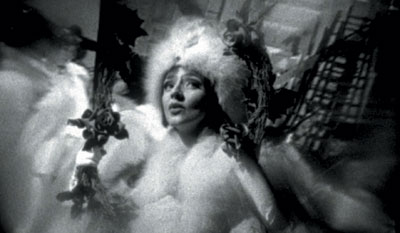SAD SONGS
By Jason McBride
 |
| Guy Maddin's The Saddest Music in the World. |
It’s been seven long years since the release of Guy Maddin’s last feature, Twilight of the Ice Nymphs, a film maligned as much by the filmmaker himself as by critics. But the past couple years have been exceedingly good — and productive — for the Canadian auteur. A sort of renaissance began with his short The Heart of the World (2000), a paean to cinephilia and Soviet micromontage that dazzled audiences from Toronto to Tampere. This summer has seen Maddin retrospectives in Rotterdam and Vienna, the theatrical release of his delirious made-for-television dance film Dracula: Pages from a Virgin’s Diary (2001), and the premiere of an autobiographical art installation, Cowards Bend the Knee (2003). The coup de graçe, however, is his return to full feature-length filmmaking glory with The Saddest Music in the World.
Based on an unpublished short story by Kazuo Ishiguro, The Saddest Music is quite literally about an international contest to create the most mournful melody ever heard. Maddin and frequent co-writer George Toles transposed the story from 1980s London to Depression-era Winnipeg, what the director fondly describes as “the saddest city in the world.”
The contest draws musicians from around the globe, and Winnipeg is soon besieged by grief-stricken mariachi bands, bathetic bagpipers and woeful West African drummers. Orchestrating all this is one Lady Port-Huntly, the hard-hearted, legless proprietress of Muskeg Beer, a brewery-cum-saloon that is the focal point of the city and the film. Port-Huntly is played by a bewigged Isabella Rossellini, who found considerable inspiration in silent-film star Lon Chaney. “I’m a freak like him,” she says, “and so is Lady Port-Huntly. She belongs with the bearded lady and the baby with two heads. She’s complete greed, complete authority, totally insensitive.”
“Only Isabella,” Maddin says proudly, “could plop herself into one of my movies without destroying the perfumes. There’s something timeless about her. She understands the Italian diva picture. And this is the first movie in which she plays a blonde. So at times it seems like she’s channeling her mother.”
Port-Huntly’s nemesis is her former lover Chester (former Kids in the Hall cast member Mark McKinney), a failed Broadway producer who returns to his hometown determined to win the contest at any cost. Standing in his way are his guilt-ridden father (himself desperately in love with Port-Huntly), Chester’s older brother Roderick, a doleful cellist recently returned from postwar Serbia, and Chester’s current companion, an amnesiac nymphomaniac named Narcissa (Henry & June’s Maria de Medeiros). Chester is down on his luck but still high on himself, appalled at the weak and mediocre country he attempted to flee.
The shoot coincided with the beginning of the conflict in Iraq (“Rossellini declares war,” Maddin quipped when local headlines were accompanied by big color pictures of the actress), and the film took on a strange relevance. The sadness and fear — not to mention the rampant anti-Americanism — that gripped the world was reflected in the film’s sly political undertones. “This is about people,” Toles says, “using their own suffering to create charades of suffering, who are willing to betray their national legacy.”
This is Maddin’s most expensive movie to date (nearly $5 million), but he steadfastly retained the more antique aspects that have served him so well in the past. The director and his crew, including d.p. Luc Montpellier, relied heavily on an arsenal of old-school camera tricks (rear projection, forced perspective, multiple exposures), while mixing and matching formats: regular, Super 8mm, Super 16mm, black-and-white and a pale-blue-and-salmon-colored two-strip Technicolor that they dubbed Melancolor. Maddin’s biggest extravagance was a 30-to-1 shooting ratio; he often employed several cameras at once, and these were operated by everyone from the first a.d. to the actors themselves. The result of all this is a stunning film pitched somewhere between Lloyd Bacon and Busby Berkeley’s Footlight Parade, Maddin’s own Archangel and musical melodramas like Compton Bennett’s The Seventh Veil.
“I’ve had such a terrible time recently with features,” Maddin says wearily. “I was just determined not to slip into an abyss this time. I just wanted to survive and use what I’d learned so far, try to be strong. But, as it turns out, I haven’t had to be strong. Everything’s worked out really well.”
VOD CALENDAR


 See the VOD Calendar →
See the VOD Calendar →


